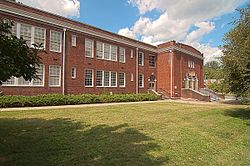
Lenoir County is a county in the U.S. state of North Carolina. As of the 2020 census, its population was 55,122. Its county seat is Kinston, located on the Neuse River, across which the county has its territory.

Lenoir is a city in and the county seat of Caldwell County, North Carolina, United States. The population was 18,263 at the 2020 census. Lenoir is located in the foothills of the Blue Ridge Mountains. To the northeast are the Brushy Mountains, a spur of the Blue Ridge Mountains. Hibriten Mountain, located just east of the city limits, marks the western end of the Brushy Mountains range.

Kinston is a city in Lenoir County, North Carolina, United States, with a population of 19,900 as of the 2020 census. It has been the county seat of Lenoir County since its formation in 1791. Kinston is located in the coastal plains region of eastern North Carolina.

La Grange is a town in Lenoir County, North Carolina, United States. The population was 2,873 based on the 2010 census. La Grange is located in North Carolina's Inner Banks region.
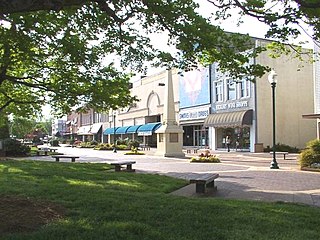
Hickory is a city in North Carolina primarily located in Catawba County. It is the 25th most populous city in North Carolina, with its formal boundaries extending into Burke and Caldwell counties. It is located approximately 60 miles (97 km) northwest of Charlotte. Hickory's population in the 2022 United States Census Bureau estimate was 44,084. Hickory is the main city of the Hickory–Lenoir–Morganton Metropolitan Statistical Area, which had a population of 368,347 in the 2022 census.

This is a list of structures, sites, districts, and objects on the National Register of Historic Places in North Carolina:
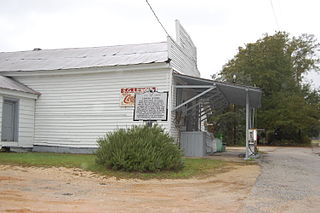
The Lenoir Store built in 1869 is an historic general store building located in the High Hills of Santee community of Horatio, South Carolina. It stands on the same site where the Lenoir family has operated a general store since before 1808 and "is the oldest business establishment in Sumter County". Since 1900 it has served as the post office for Horatio Zip Code 29062. On July 3, 1997, it was added to the National Register of Historic Places. As of that date, it was still being operated by members of the Lenoir family. Lenoir is pronounced le-nore or len-wa by some of its more northern members.

The La Grange Presbyterian Church, also known as the La Grange Rotary Club, is a historic Presbyterian church building located on Caswell Street in La Grange, Lenoir County, North Carolina. It was constructed in 1892, and is a Gothic Revival style frame building.
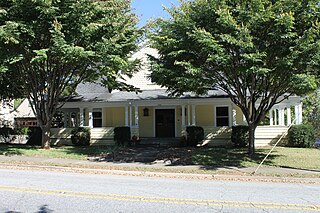
The Edgar Allan Poe House is a historic home located in Caldwell County at 506 Main Street NW in Lenoir, North Carolina.
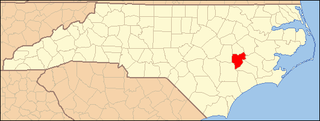
This list includes properties and districts listed on the National Register of Historic Places in Lenoir County, North Carolina. Click the "Map of all coordinates" link to the right to view an online map of all properties and districts with latitude and longitude coordinates in the table below.

The Caldwell County Courthouse in Lenoir, North Carolina was designed by Wheeler & Runge in Classical Revival style. It was built in 1905.
Louis H. Asbury (1877–1975) was an American architect, a leading architect of Charlotte, North Carolina. He is asserted to be the "first professionally trained, fulltime architect in North Carolina who was born and practiced in the state."

Fort Defiance is a historic plantation house located near Lenoir, Caldwell County, North Carolina. The main block was built between 1788 and 1792, and is a two-story, frame structure measuring 28 feet by 40 feet. A wing was added in 1823. It was the home of Revolutionary War General William Lenoir. The property was transferred to the Caldwell County Historical Society in 1965 and operated as a historic house museum.

Lenoir High School is a historic high school complex and national historic district located at Lenoir, Caldwell County, North Carolina. It was designed by the architectural firm Benton & Benton and built in 1922. It is a two-story, Classical Revival-style brick school with cast stone detailing. An addition was made in 1962. Connected to the main building by brick walls is the contributing 1935–1937 band building with additions. The property also has an original stone retaining wall. Lenoir High School closed its doors in 1977, when it merged with Gamewell-Collettsville High School and moved across town to form West Caldwell High School. The Lenoir High School building was then Willow St Middle School until 1981. The property was vacant for eight years before becoming a senior housing facility in 1989.
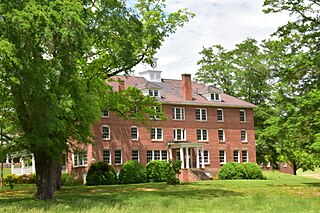
Patterson School Historic District is a historic agricultural and Episcopal mission school complex and national historic district located at Legerwood, Caldwell County, North Carolina. The complex includes 13 contributing buildings, 2 contributing sites, and 3 contributing structures. Notable contributing resources include the Colonial Revival-style Palmyra Hall (1927), Sarah Joyce Lenoir Memorial Library, Gard Hall (1920-1921), Headmaster's House (1912), Buffalo Creek Dam (pre-1940), Milk House (1945), two Barns, North Silo (1920s), Chapel of Rest (1918), Jones-Patterson Cemetery, Hugh A. Dobbin House, and Tudor Revival-style Edgar A. Dobbin House (Greystone) (1930s). In 1994 the Episcopal Diocese of Western North Carolina sold the Patterson School property.

Lenoir Downtown Historic District is a national historic district located at Lenoir, Caldwell County, North Carolina. The district includes 41 contributing buildings and 2 contributing objects in the central business district of Lenoir. It includes commercial, governmental, and institutional buildings in a variety of popular architectural styles including Art Deco, Art Moderne, Classical Revival and Tudor Revival. Notable contributing resources include the Center Theater (1941), O. P. Lutz Furniture Company and Lutz Hosiery Mill (1939), Dayvault's Drug Store (1937), Caldwell County Agricultural Building (1937), Courtney Warehouse, Masonic Hall, Miller Building, Confederate Monument (1910), Belk's Department Store (1928), Lenoir Building (1907), J. C. Penney Department Store, Fidelity Building (1928), and U. S. Post Office (1931). Located in the district is the separately listed Caldwell County Courthouse.

Lenoir County Courthouse is a historic courthouse located at Kinston, Lenoir County, North Carolina. It was built in 1939, and is a three-story, "H"-shaped, Moderne style building. It is faced with a limestone veneer and accented by streamlined, stylized ornament. It features a tetrastyle in antis portico of square fluted piers.
Yadkin Valley is an unincorporated community in Caldwell County, North Carolina, United States. The community is on North Carolina Highway 268 7.9 miles (12.7 km) north-northeast of Lenoir.
Legerwood is an unincorporated community in Caldwell County, North Carolina, United States. The community is on North Carolina Highway 268 7 miles (11 km) north of Lenoir.

The Lenoir Cotton Mill, later the Blue Bell Inc. Plant is a historic textile mill and factory in Lenoir, North Carolina.
